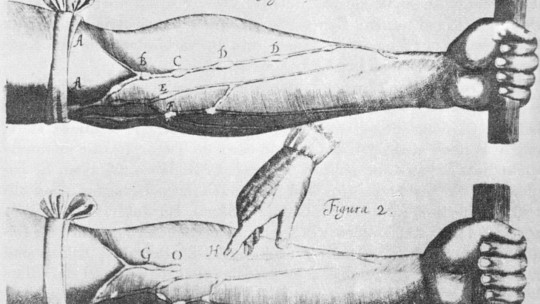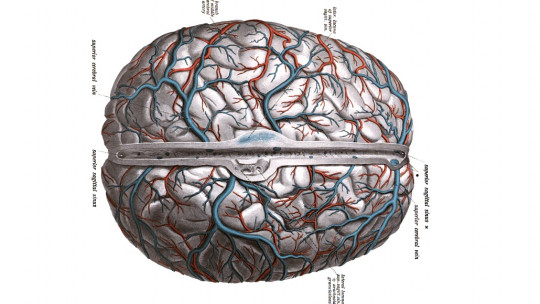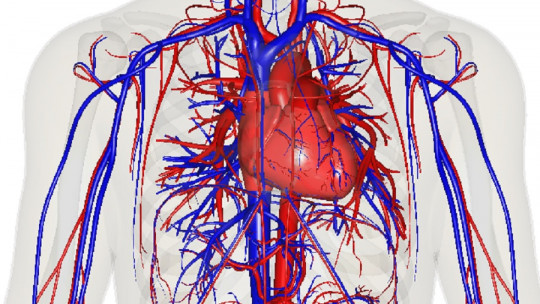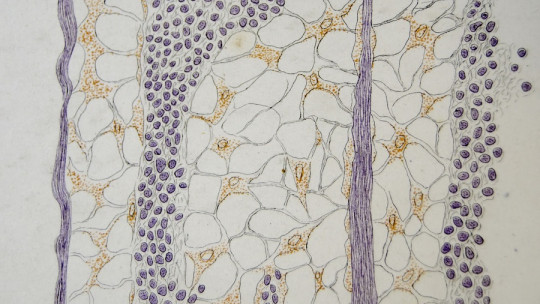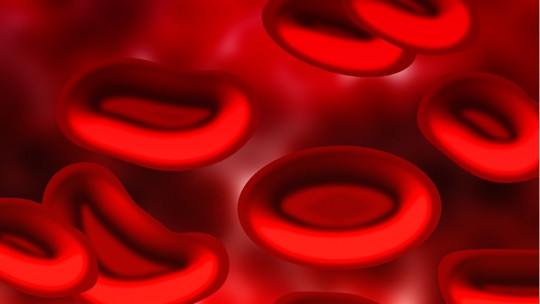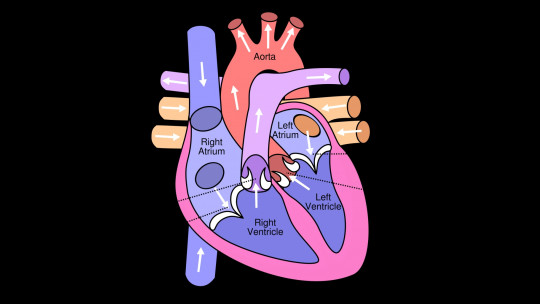The circulatory system is a transport system that living beings use to move nutritional elements, metabolic compounds, oxygen, carbon dioxide, hormones and many other substances within our body. Blood flows through this system of veins, arteries and capillaries, a reddish liquid whose hue is attributable to red blood cells, which transport oxygen to each and every cell in the body.
An adult human being has approximately 5,000,000 red blood cells per microliter of blood, that is, 1,000 times more than the proportion of white blood cells. Furthermore, from end to end (and counting veins, arteries and capillaries), our circulatory system would occupy in a straight line about 100,000 kilometers, 2.5 times the circumference of the Earth. As you can see, this transportation network moves in astronomical figures.
Beyond the importance of the circulatory system, the energy expenditure of the heart, heart diseases and their impact on society and many other informative topics, there is a term referring to the circulatory system that not everyone knows. We tell you everything about vasodilation and what it implies on a physiological level
What is vasodilation?
Vasodilation is a process in which the diameter of blood vessels increases (veins or arteries), after which a more hollow cavity is formed and greater blood flow is allowed. This concept is contrary to that of vasoconstriction, an event in which the vessels narrow due to the action of small muscles in their walls.
The University of Navarra Clinic (CUN) provides a much more exact medical definition of the term: “A dilation of the lumen of the blood vessels, either as a consequence of an increase in intravascular pressure (passive vasodilation), or, more frequently , due to a decrease in vasomotor tone, as a consequence of the relaxation of the vascular muscles.”
Generally, vasodilation has a positive connotation and vasoconstriction is associated with pathological processes This is mainly due to the fact that vasodilation commonly occurs in response to natural events, such as low oxygen levels in the body or an increase in body temperature (physiological processes that occur during sports, for example). ).
When does vasodilation occur?
There are multiple causes why vasodilation can occur in the body. Among them, we find the following:
As you can see, vasodilation generally has a specific purpose: to increase blood flow to an area that requires more oxygen, nutrients, or cellular action.
The case of inflammation is especially striking, since it makes great biological sense for the diameter of veins and capillaries to widen to allow greater blood flow to the affected area. Macrophages and mast cells, cells of the immune system that generally respond to pathogen attacks, act locally and cause fluid to leak from the blood into the tissues, generating edema.
The process of alcohol consumption is also very interesting. These drinks, at the level of the circulatory system, increase cardiac activity and produce peripheral vasodilation, which explains the redness of the skin and the increase in surface temperature after consumption.
Curiously, this does not help to resist the cold more, since greater superficial blood flow implies higher heat loss. Medical portals stipulate, therefore, that there could be a greater risk of hypothermia after alcohol poisoning in an exceptionally cold environment.
Spontaneous vasodilation
Spontaneous vasodilation of a tissue implies a rapid response of the tissue to a stimulus, in order to obtain a greater required blood flow. Strong emotions, such as joy, despair or fear, lead to the heart working harder to pump blood As a consequence, vasodilation is activated to result in a more consistent and stronger blood flow.
Have you ever wondered why we turn red when we make a mistake? When a human being feels that he has done something wrong or blushes for any other reason, the parasympathetic system is activated and adrenaline is released throughout the bloodstream. This causes an increase in heart rate, agitation of breathing, increased sweating and a characteristic vasodilation in the facial area Therefore, since there is a greater flow of blood under the skin, it is said that the person has blushed (literally, there is a greater flow of blood).
Vasodilation and temperature
It is known to every biologist that vasodilation is an excellent regulatory mechanism in all animals with a blood system. When it is very hot, the superficial thermoreceptors send the signal to the brain that something needs to be done to dissipate heat.
For this reason, a vasodilation process is activated, which allows blood to flow to the outer layers of the skin This promotes a thermal exchange with the environment, which helps the individual lower their body temperature.
If you look at a fennec (a desert fox), you will see that it has disproportionately large ears compared to the rest of its body. This characteristic is not anecdotal: in addition to excellent listening, it gives the animal greater surface irrigation, which allows heat to be dissipated during the hottest times of the day Fascinating, right?
Diseases associated with this physiological process
Although we have previously said that vasodilation is usually associated with health, this is not always the case. Below, we present some diseases that are relatively related to this physiological event.
Shock
Shock has several causes: a low volume of blood in the body, inadequate cardiac pumping capacity and excessive widening of blood vessels, or in other words, vasodilation (also known as distributive shock).
If it is exaggerated, the dilation of blood vessels can reduce pressure This, in some cases, leads to decreased blood flow and a lower delivery of nutrients and oxygen to certain tissues in the body. Blood vessels can dilate excessively for reasons such as:
Low blood pressure (hypotension)
This event is closely linked to the previous case. When blood pressure is much lower than normal, the patient may experience a serious deficit on a physiological level This causes nausea, dizziness, confusion, discomfort and even loss of consciousness in the individual.
Hypotension can cause the previously described shock if it occurs pathologically, so sometimes a rapid medical approach is necessary. This includes giving blood intravenously, medications to increase blood pressure and heart strength, and other drugs.
The vasodilators
Vasodilators, as their name suggests, are medications that widen (vasodilate) blood vessels. These act directly on the muscles of the walls of veins and arteries, preventing them from contracting and the diameter of the space from decreasing. As a result of taking these drugs, blood flows more easily through the tubes, which prevents the heart from pumping as fast, thereby lowering high blood pressure.
Doctors typically prescribe the use of vasodilators in the following scenarios: high blood pressure (regularly or during pregnancy and childbirth), heart failure and pulmonary hypertension, among other clinical conditions
In any case, the use of vasodilators is not risk-free. Medical portals report that they report certain side effects, such as an increased heart rate (tachycardia), palpitations, nausea, vomiting, redness, headache and many other clinical signs. Therefore, their consumption is only considered when a medical professional has prescribed them for a specific reason.
Summary
Vasodilation is a normal physiological process, as it occurs when we are nervous, when exercising, when the temperature increases, with alcohol consumption and in many other common events during the life of the individual.
Unfortunately, there are certain pathological processes that can arise in response to excessive vasodilation. Hypotension can cause not enough blood and oxygen to reach the brain and other organs in the body, which can be life-threatening.
- Shock, MSDmanuals. Collected on January 31 at https://www.msdmanuals.com/es/hogar/trastornos-del-coraz%C3%B3n-y-los-vasos-sangu%C3%ADneos/presi%C3%B3n-arterial- low-and-shock-shock/shock-shock#:~:text=The%20excessive%20dilation%20of%20the%20ox%C3%ADgene%20to%20the%20%C3%B3organs.&text =The%20mechanisms%20by%20that%20these%20diseases%20produce%20vasodilation%C3%B3n%20are%20varied.
- Vasodilatation, University of Navarra Clinic. Collected on January 31 at https://www.cun.es/diccionario-medico/terminos/vasodilatacion
- Vasodilators, Mayoclinic.org. Collected on January 31 at https://www.mayoclinic.org/es-es/diseases-conditions/high-blood-pressure/in-depth/high-blood-pressure-medication/art-20048154


